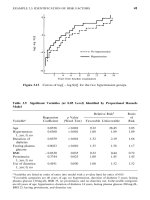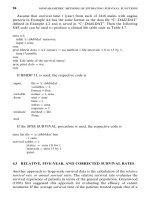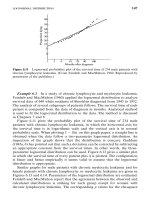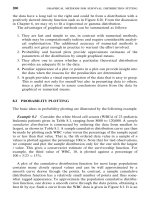Derivatives analytics with python data analysis, models, simulation, calibration and hedging
Bạn đang xem bản rút gọn của tài liệu. Xem và tải ngay bản đầy đủ của tài liệu tại đây (6.47 MB, 377 trang )
Derivatives
Analytics
with Python
For other titles in the Wiley Finance series
please see www.wiley.com/finance
Derivatives
Analytics
with Python
Data Analysis, Models, Simulation,
Calibration and Hedging
YVES HILPISCH
This edition first published 2015
© 2015 John Wiley & Sons Ltd
Registered office
John Wiley & Sons Ltd, The Atrium, Southern Gate, Chichester, West Sussex, PO19 8SQ, United
Kingdom
For details of our global editorial offices, for customer services and for information about how to apply
for permission to reuse the copyright material in this book please see our website at www.wiley.com.
All rights reserved. No part of this publication may be reproduced, stored in a retrieval system, or
transmitted, in any form or by any means, electronic, mechanical, photocopying, recording or
otherwise, except as permitted by the UK Copyright, Designs and Patents Act 1988, without the prior
permission of the publisher.
Wiley publishes in a variety of print and electronic formats and by print-on-demand. Some material
included with standard print versions of this book may not be included in e-books or in
print-on-demand. If this book refers to media such as a CD or DVD that is not included in the version
you purchased, you may download this material at . For more information
about Wiley products, visit www.wiley.com.
Designations used by companies to distinguish their products are often claimed as trademarks. All
brand names and product names used in this book are trade names, service marks, trademarks or
registered trademarks of their respective owners. The publisher is not associated with any product or
vendor mentioned in this book.
Limit of Liability/Disclaimer of Warranty: While the publisher and author have used their best efforts
in preparing this book, they make no representations or warranties with respect to the accuracy or
completeness of the contents of this book and specifically disclaim any implied warranties of
merchantability or fitness for a particular purpose. It is sold on the understanding that the publisher is
not engaged in rendering professional services and neither the publisher nor the author shall be liable
for damages arising herefrom. If professional advice or other expert assistance is required, the services
of a competent professional should be sought.
Library of Congress Cataloging-in-Publication Data
Hilpisch, Yves J.
Derivatives analytics with Python : data analysis, models, simulation, calibration and hedging /
Yves Hilpisch.—1
pages cm.—(The Wiley finance series)
Includes bibliographical references and index.
ISBN 978-1-119-03799-6 (hardback)
1. Derivative securities. 2. Hedging (Finance) 3. Python (Computer program language)
I. Title.
HG6024.A3H56 2015
2015010191
332.64′ 5702855133—dc23
A catalogue record for this book is available from the British Library.
ISBN 978-1-119-03799-6 (hardback) ISBN 978-1-119-03793-4 (ebk)
ISBN 978-1-119-03800-9 (ebk)
ISBN 978-1-119-03801-6 (obk)
Cover Design: Wiley
Cover Images: Top image (c)iStock.com/agsandrew; Bottom image (c)iStock.com/stocksnapper
Set in 10/12pt Times by Aptara Inc., New Delhi, India
Printed in Great Britain by TJ International Ltd, Padstow, Cornwall, UK
Contents
List of Tables
xi
List of Figures
xiii
Preface
xvii
CHAPTER 1
A Quick Tour
1.1
1.2
1.3
1.4
Market-Based Valuation
Structure of the Book
Why Python?
Further Reading
1
1
2
3
4
PART ONE
The Market
CHAPTER 2
What is Market-Based Valuation?
2.1
2.2
2.3
2.4
2.5
Options and their Value
Vanilla vs. Exotic Instruments
Risks Affecting Equity Derivatives
2.3.1 Market Risks
2.3.2 Other Risks
Hedging
Market-Based Valuation as a Process
CHAPTER 3
Market Stylized Facts
3.1
3.2
3.3
Introduction
Volatility, Correlation and Co.
Normal Returns as the Benchmark Case
9
9
13
14
14
15
16
17
19
19
19
21
v
vi
CONTENTS
3.4
3.5
3.6
3.7
3.8
Indices and Stocks
3.4.1 Stylized Facts
3.4.2 DAX Index Returns
Option Markets
3.5.1 Bid/Ask Spreads
3.5.2 Implied Volatility Surface
Short Rates
Conclusions
Python Scripts
3.8.1 GBM Analysis
3.8.2 DAX Analysis
3.8.3 BSM Implied Volatilities
3.8.4 EURO STOXX 50 Implied Volatilities
3.8.5 Euribor Analysis
25
25
26
30
31
31
33
36
37
37
40
41
43
45
PART TWO
Theoretical Valuation
CHAPTER 4
Risk-Neutral Valuation
4.1 Introduction
4.2 Discrete-Time Uncertainty
4.3 Discrete Market Model
4.3.1 Primitives
4.3.2 Basic Definitions
4.4 Central Results in Discrete Time
4.5 Continuous-Time Case
4.6 Conclusions
4.7 Proofs
4.7.1 Proof of Lemma 1
4.7.2 Proof of Proposition 1
4.7.3 Proof of Theorem 1
CHAPTER 5
Complete Market Models
5.1 Introduction
5.2 Black-Scholes-Merton Model
5.2.1 Market Model
5.2.2 The Fundamental PDE
5.2.3 European Options
5.3 Greeks in the BSM Model
5.4 Cox-Ross-Rubinstein Model
5.5 Conclustions
5.6 Proofs and Python Scripts
5.6.1 Itˆo’s Lemma
49
49
50
54
54
55
57
61
66
66
66
67
68
71
71
72
72
72
74
76
81
84
84
84
vii
Contents
5.6.2
5.6.3
5.6.4
Script for BSM Option Valuation
Script for BSM Call Greeks
Script for CRR Option Valuation
CHAPTER 6
Fourier-Based Option Pricing
6.1
6.2
6.3
6.4
6.5
6.6
6.7
6.8
Introduction
The Pricing Problem
Fourier Transforms
Fourier-Based Option Pricing
6.4.1 Lewis (2001) Approach
6.4.2 Carr-Madan (1999) Approach
Numerical Evaluation
6.5.1 Fourier Series
6.5.2 Fast Fourier Transform
Applications
6.6.1 Black-Scholes-Merton (1973) Model
6.6.2 Merton (1976) Model
6.6.3 Discrete Market Model
Conclusions
Python Scripts
6.8.1 BSM Call Valuation via Fourier Approach
6.8.2 Fourier Series
6.8.3 Roots of Unity
6.8.4 Convolution
6.8.5 Module with Parameters
6.8.6 Call Value by Convolution
6.8.7 Option Pricing by Convolution
6.8.8 Option Pricing by DFT
6.8.9 Speed Test of DFT
CHAPTER 7
Valuation of American Options by Simulation
7.1 Introduction
7.2 Financial Model
7.3 American Option Valuation
7.3.1 Problem Formulations
7.3.2 Valuation Algorithms
7.4 Numerical Results
7.4.1 American Put Option
7.4.2 American Short Condor Spread
7.5 Conclusions
7.6 Python Scripts
7.6.1 Binomial Valuation
7.6.2 Monte Carlo Valuation with LSM
7.6.3 Primal and Dual LSM Algorithms
85
88
92
95
95
96
97
98
98
101
103
103
105
107
107
108
110
114
114
114
119
120
121
122
123
123
124
125
127
127
128
128
128
130
132
132
135
136
137
137
139
140
viii
CONTENTS
PART THREE
Market-Based Valuation
CHAPTER 8
A First Example of Market-Based Valuation
8.1
8.2
8.3
8.4
8.5
8.6
8.7
Introduction
Market Model
Valuation
Calibration
Simulation
Conclusions
Python Scripts
8.7.1 Valuation by Numerical Integration
8.7.2 Valuation by FFT
8.7.3 Calibration to Three Maturities
8.7.4 Calibration to Short Maturity
8.7.5 Valuation by MCS
CHAPTER 9
General Model Framework
9.1
9.2
9.3
9.4
9.5
Introduction
The Framework
Features of the Framework
Zero-Coupon Bond Valuation
European Option Valuation
9.5.1 PDE Approach
9.5.2 Transform Methods
9.5.3 Monte Carlo Simulation
9.6 Conclusions
9.7 Proofs and Python Scripts
9.7.1 Itˆo’s Lemma
9.7.2 Python Script for Bond Valuation
9.7.3 Python Script for European Call Valuation
CHAPTER 10
Monte Carlo Simulation
10.1
10.2
10.3
10.4
10.5
10.6
Introduction
Valuation of Zero-Coupon Bonds
Valuation of European Options
Valuation of American Options
10.4.1 Numerical Results
10.4.2 Higher Accuracy vs. Lower Speed
Conclusions
Python Scripts
10.6.1 General Zero-Coupon Bond Valuation
10.6.2 CIR85 Simulation and Valuation
147
147
147
148
149
149
155
155
155
157
160
163
165
169
169
169
170
172
173
173
175
176
177
177
177
178
180
187
187
188
192
196
198
201
203
204
204
205
ix
Contents
10.6.3
10.6.4
Automated Valuation of European Options by Monte
Carlo Simulation
Automated Valuation of American Put Options by Monte
Carlo Simulation
CHAPTER 11
Model Calibration
11.1
11.2
11.3
11.4
11.5
11.6
Introduction
General Considerations
11.2.1 Why Calibration at All?
11.2.2 Which Role Do Different Model Components Play?
11.2.3 What Objective Function?
11.2.4 What Market Data?
11.2.5 What Optimization Algorithm?
Calibration of Short Rate Component
11.3.1 Theoretical Foundations
11.3.2 Calibration to Euribor Rates
Calibration of Equity Component
11.4.1 Valuation via Fourier Transform Method
11.4.2 Calibration to EURO STOXX 50 Option Quotes
11.4.3 Calibration of H93 Model
11.4.4 Calibration of Jump Component
11.4.5 Complete Calibration of BCC97 Model
11.4.6 Calibration to Implied Volatilities
Conclusions
Python Scripts for Cox-Ingersoll-Ross Model
11.6.1 Calibration of CIR85
11.6.2 Calibration of H93 Stochastic Volatility Model
11.6.3 Comparison of Implied Volatilities
11.6.4 Calibration of Jump-Diffusion Part of BCC97
11.6.5 Calibration of Complete Model of BCC97
11.6.6 Calibration of BCC97 Model to Implied Volatilities
CHAPTER 12
Simulation and Valuation in the General Model Framework
12.1
12.2
12.3
12.4
12.5
Introduction
Simulation of BCC97 Model
Valuation of Equity Options
12.3.1 European Options
12.3.2 American Options
Conclusions
Python Scripts
12.5.1 Simulating the BCC97 Model
12.5.2 Valuation of European Call Options by MCS
12.5.3 Valuation of American Call Options by MCS
209
215
223
223
223
224
226
227
228
229
230
230
231
233
235
236
236
237
239
240
243
243
243
248
251
252
256
258
263
263
263
266
266
268
268
269
269
274
275
x
CONTENTS
CHAPTER 13
Dynamic Hedging
13.1
13.2
13.3
13.4
13.5
Introduction
Hedging Study for BSM Model
Hedging Study for BCC97 Model
Conclusions
Python Scripts
13.5.1 LSM Delta Hedging in BSM (Single Path)
13.5.2 LSM Delta Hedging in BSM (Multiple Paths)
13.5.3 LSM Algorithm for American Put in BCC97
13.5.4 LSM Delta Hedging in BCC97 (Single Path)
279
279
280
285
289
289
289
293
295
300
CHAPTER 14
Executive Summary
303
APPENDIX A
Python in a Nutshell
305
A.1 Python Fundamentals
A.1.1 Installing Python Packages
A.1.2 First Steps with Python
A.1.3 Array Operations
A.1.4 Random Numbers
A.1.5 Plotting
A.2 European Option Pricing
A.2.1 Black-Scholes-Merton Approach
A.2.2 Cox-Ross-Rubinstein Approach
A.2.3 Monte Carlo Approach
A.3 Selected Financial Topics
A.3.1 Approximation
A.3.2 Optimization
A.3.3 Numerical Integration
A.4 Advanced Python Topics
A.4.1 Classes and Objects
A.4.2 Basic Input-Output Operations
A.4.3 Interacting with Spreadsheets
A.5 Rapid Financial Engineering
305
305
306
310
313
314
316
316
318
323
325
325
328
329
330
330
332
334
336
Bibliography
341
Index
347
List of Tables
3.1
3.2
5.1
7.1
7.2
10.1
10.2
10.3
10.4
10.5
Option bid/ask spreads for call options on stocks of the DJIA index
Option bid/ask spreads for put options on stocks of the DJIA index
Valuation results from the CRR binomial algorithm for the European call
option; upper panel index level process, lower panel option value process
Valuation results from the LSM and DUAL algorithms for the American put
option from 25 different simulation runs with base case parametrization
Valuation results from the LSM and DUAL algorithms for the Short Condor
Spread from 25 different simulation runs with base case parametrization
Valuation results for European call and put options in H93 model for
parametrizations from Medvedev and Scaillet (2010) and M0 = 50,
I = 100,000. Performance yardsticks are PY1 = 0.025 and PY1 = 0.015.
Valuation results for European call and put options in H93 model for
parametrizations from Medvedev and Scaillet (2010) and M0 = 50,
I = 100,000. Performance yardsticks are PY1 = 0.025 and PY1 = 0.015.
Valuation results for American put options in H93 and CIR85 model for
parametrizations from Medvedev and Scaillet (2010). Performance yardsticks
are PY1 = 0.025 and PY1 = 0.015
Valuation results for American put options in H93 and CIR85 model for
parametrizations from Medvedev and Scaillet (2010). Performance yardsticks
are PY1 = 0.025 and PY1 = 0.015.
Valuation results for American put options in H93 and CIR85 model for
parametrizations from Medvedev and Scaillet (2010). Performance yardsticks
are PY1 = 0.01 and PY1 = 0.01
31
32
82
134
135
195
197
200
202
203
xi
List of Figures
2.1
2.2
3.1
3.2
3.3
3.4
3.5
3.6
3.7
3.8
3.9
3.10
3.11
3.12
3.13
3.14
Inner value of a European call option on a stock index with strike of 8,000
dependent on the index level at maturity
Black-Scholes-Merton value of a European call option on a stock index with
K = 9000, T = 1.0, r = 0.025 and 𝜎 = 0.2 dependent on the initial index
level S0 ; for comparison, the undiscounted inner value is also shown
A single simulated path for the geometric Brownian motion over a 10-year
period with daily log returns
Histogram of the daily log returns (bars) and for comparison the probability
density function of the normal distribution with the sample mean and
volatility (line)
Quantile-quantile plot of the daily log returns of the geometric Brownian
motion
Realized volatility for the simulated path of the geometric Brownian motion
Rolling mean log return (252 days), rolling volatility (252 days) and rolling
correlation between both (252 days) for geometric Brownian motion; dashed
lines are averages over the whole period shown
DAX index level quotes and daily log returns over the period from 01.
October 2004 to 30. September 2014
Histogram of the daily log returns of the DAX over the period from 01.
October 2004 to 30. September 2014 (bars) and for comparison the
probability density function of the normal distribution with the sample mean
and volatility (line)
Quantile-quantile plot of the daily log returns of the DAX over the period
from 01. October 2004 to 30. September 2014
Realized volatility for the DAX over the period from 01. October 2004 to 30.
September 2014
Rolling mean log return (252 days), rolling volatility (252 days) and rolling
correlation between both (252 days); dashed lines are averages over the
whole period shown
Implied volatilities from European call options on the EURO STOXX 50 on
30. September 2014
Daily quotes of 1 week Euribor and daily log changes over the period from
01. January 1999 to 30. September 2014
Histogram of daily log changes in 1 week Euribor in comparison to a normal
distribution with same mean and standard deviation (line)
Quantile-quantile plot of the daily log changes in the 1 week Euribor
10
12
22
22
23
24
25
27
27
28
29
30
33
34
35
35
xiii
xiv
3.15
5.1
5.2
5.3
5.4
5.5
5.6
5.7
5.8
5.9
6.1
6.2
6.3
6.4
7.1
7.2
8.1
8.2
8.3
10.1
10.2
LIST OF FIGURES
Daily quotes of 1 week (dotted), 1 month (dot-dashed), 6 months (dashed)
and 1 year Euribor (solid line) over the period from 01. January 1999 to 30.
September 2014
Value of the example European call option for varying strike K, maturity date
T, short rate r and volatility 𝜎
Value of the example European put option for varying strike K, maturity date
T, short rate r and volatility 𝜎
The delta of the European call option with respect to maturity date T and
strike K
The gamma of the European call option with respect to maturity date T and
strike K
The theta of the European call option with respect to maturity date T and
strike K
The rho of the European call option with respect to maturity date T and strike
K
The vega of the European call option with respect to maturity date T and
strike K
European call option values from the CRR model for increasing number of
time intervals M—step size of 20 intervals
European call option values from the CRR model for increasing number of
time intervals M—step size of 25 intervals
Fourier series approximation of function f (x) = |x| of order 1 (left) and of
order 5 (right)
Valuation accuracy of Lewis’ integral approach in comparison to BSM
analytical formula; parameter values are S0 = 100, T = 1.0, r = 0.05, 𝜎 = 0.2
Valuation accuracy of CM99 FFT approach in comparison to BSM analytical
formula; parameter values are S0 = 100, T = 1.0, r = 0.05, 𝜎 = 0.2,
N = 4,096, 𝜖 = 150−1
Series with roots of unity for n = 5 and n = 30 plotted in the imaginary plane
Valuation results for the American put option from 25 simulation runs with
M = 75 time intervals; AV = average of primal (LSM) and dual (DUAL)
values; dashed line = true value
Valuation results for the American Short Condor Spread from 25 simulation
runs with M = 75 time intervals; AV = average of primal (LSM) and dual
(DUAL) values; dashed line = true value
Results of the calibration of Merton’s jump-diffusion model to market quotes
for three maturities; lines = market quotes, dots = model prices
Results of the calibration of Merton’s jump-diffusion model to a small subset
of market quotes (i.e. a single maturity only; here: shortest maturity); line =
market quotes, dots = model prices, bars = difference between model values
and market quotes
Comparison of European call option values from Lewis formula (line), from
Carr-Madan formula (triangles) and Monte Carlo simulation (dots)
Twenty simulated paths for the CIR85 short rate process
Values for a ZCB maturing at T = 2; line = analytical values, dots = Monte
Carlo simulation estimates from the exact scheme for M = 50 and I = 50,000
36
76
77
78
79
79
80
80
83
83
106
108
109
111
134
136
150
151
152
190
191
List of Figures
10.3
10.4
11.1
11.2
11.3
11.4
11.5
11.6
11.7
11.8
11.9
11.10
12.1
12.2
12.3
12.4
13.1
13.2
13.3
13.4
13.5
13.6
Values for a ZCB maturing at T = 2; line = analytical values, dots = Monte
Carlo simulation estimates from the Euler scheme for M = 50 and I = 50,000
Boxplot of Monte Carlo valuation errors without and with moment matching
Euribor term structure up to 12 months (incl. Eonia rate); points = market
quotes from 30. September 2014, line = interpolated curve, dashed line = 1st
derivative of term structure curve
Market and model implied forward rates for Euribor; line = market forward
rates from 30. September 2014, dots = model implied forward rates; bars =
the difference between the model and market forward rates
Unit zero-coupon bond values at time t maturing at time T = 2
Results of H93 model calibration to EURO STOXX 50 option quotes; line =
market quotes from 30. September, red dots = model values after calibration
Implied volatilities from H93 model calibration to EURO STOXX 50 option
quotes from 30. September 2014
Results of BCC97 jump-diffusion part calibration to five European call
options on the EURO STOXX 50 with 17 days maturity; market quotes from
30. September 2014
Results of simultaneous BCC97 jump-diffusion and stochastic volatility part
calibration to 15 European call options on the EURO STOXX 50 with 17, 80
and 171 days maturity, respectively; quotes from 30. September 2014
Implied volatilities from BCC97 model calibration to EURO STOXX 50
option quotes from 30. September 2014
Results of BCC97 calibration to 15 market implied volatilities of EURO
STOXX 50 European call options with 17, 80 and 171 days maturity,
respectively; market quotes from 30. September 2014
Implied volatilities from BCC97 model calibration to EURO STOXX 50
implied volatilities from 30. September 2014
Ten simulated short rate paths from calibrated CIR85 model for a time
horizon of 1 year (starting 30. September 2014) and 25 time intervals
Ten simulated volatility paths from calibrated BCC97 model for a time
horizon of 1 year (starting 30. September 2014) and 25 time intervals
Ten simulated EURO STOXX 50 level paths from calibrated BCC97 model
for a time horizon of 1 year (starting 30. September 2014) and 25 time
intervals
Histogram of simulated EURO STOXX 50 levels from calibrated BCC97
model after a time period of 1 year (i.e. on 30. September 2015)
Dynamic replication of American put option in BSM model with profit at
exercise
Dynamic replication of American put option in BSM model with loss at
exercise
Frequency distribution of (discounted) P&L at exercise date of 10,000
dynamic replications of American put option in BSM model
Frequency distribution of (discounted) P&L at exercise date of 10,000
dynamic replications of American put option in BSM model with more time
steps and paths used
Dynamic replication of American put option in BCC97 with profit at maturity
Dynamic replication of American put option in BCC97 with loss at maturity
xv
191
196
233
234
234
237
238
240
241
242
243
244
264
264
265
265
281
283
284
285
287
288
xvi
13.7
13.8
A.1
A.2
A.3
A.4
A.5
A.6
A.7
A.8
LIST OF FIGURES
Frequency distribution of (discounted) P&L at exercise date of 10,000
dynamic replications of American put option in general market model BCC97
Dynamic replication of American put option in BCC97 with huge loss at
exercise due to an index jump
Example of figure with matplotlib—here: line
Example of figure with matplotlib—here: dots and bars
Histogram of simulated stock index levels at T
Approximation of cosine function (line) by constant regression (crosses),
linear regression (dots) and quadratic regression (triangles)
Approximation of cosine function (line) by cubic splines interpolation (red
dots)
Sample spreadsheet in Excel format with DAX quotes (here shown with
LibreOffice)
Historic DAX index levels
DAX index quotes from 03. January 2005 to 28. November 2014 and daily
log returns
288
289
314
315
324
326
327
335
336
339
Preface
T
his book is an outgrowth of diverse activities of myself and colleagues of mine in the fields
of financial engineering, computational finance and Python programming at our company
The Python Quants GmbH on the one hand and of teaching mathematical finance at Saarland
University on the other hand.
The book is targeted at practitioners, researchers and students interested in the marketbased valuation of options from a practical perspective, i.e. the single numerical and technical
implementation steps that make up such an effort. It is also for those who want to learn how
Python can be used for derivatives analytics and financial engineering. However, apart from
being primarily practical and implementation-oriented, the book also provides the necessary
theoretical foundations and numerical tools.
My hope is that the book will contribute to the increasing acceptance of Python in
the financial community, and in particular in the analytics space. If you are interested in
getting the Python scripts and IPython Notebooks accompanying the book, you should visit
where you can register for the Quant Platform which allows
browser-based, interactive and collaborative financial analytics. Further resources are found on
the website . You should also check out the open
source library DX Analytics under which implements the concepts
and methods presented in the book in standardized, reusable fashion.
I thank my family—and in particular my wife Sandra—for their support and understanding
that such a project requires many hours of solitude. I also want to thank my colleague Michael
Schwed for his continuous help and support. In addition, I thank Alain Ledon and Riaz Ahmad
for their comments and feedback. Discussions with participants of seminars and my lectures
at Saarland University also helped the project significantly. Parts of this book have benefited
from talks I have given at diverse Python and finance conferences over the years.
I dedicate this book to my lovely son Henry Nikolaus whose direct approach to living and
clear view of the world I admire.
Yves Hilpisch
Saarland, February 2015
xvii
CHAPTER
1
A Quick Tour
1.1 MARKET-BASED VALUATION
This book is about the market-based valuation of (stock) index options. In the domain of
derivatives analytics this is an important task which every major investment bank and buy-side
decision maker in the financial market is concerned with on a daily basis. While theoretical
valuation approaches develop a model, parametrize it and then derive values for options, the
market-based approach works the other way round. Prices from liquidly traded options are
taken as given (i.e. they are inputs instead of outputs) and one tries to parametrize a market
model in a way that replicates the observed option prices as well as possible. This activity is
generally referred to as model calibration. Being equipped with a calibrated model, one then
proceeds with the task at hand, be it valuation, trading, investing, hedging or risk management.
A bit more specifically, one might be interested in pricing and hedging an exotic derivative
instrument with such a model—hoping that the results are in line with the overall market
(i.e. arbitrage-free and even “fair”) due to the previous calibration to more simple, vanilla
instruments.
To accomplish a market-based valuation, four areas have to be covered:
1. market: knowledge about market realities is a conditio sine qua non for any sincere
attempt to develop market-consistent models and to accomplish market-based valuation
2. theory: every valuation must be grounded on a sound market model, ensuring, for example, the absence of arbitrage opportunities and providing means to derive option values
from observed quantities
3. numerics: one cannot hope to work with analytical results only; numerical techniques,
like Monte Carlo simulation, are generally required in different steps of a market-based
valuation process
4. technology: to implement numerical techniques efficiently, one is dependent on appropriate technology (hard- and software)
This book covers all of these areas in an integrated manner. It uses equity index options
as the prime example for derivative instruments throughout. This, among others, allows to
abstract from dividend related issues.
1
2
DERIVATIVES ANALYTICS WITH PYTHON
1.2 STRUCTURE OF THE BOOK
The book is divided into three parts. The first part is concerned with market-based valuation
as a process and empirical findings about market realities. The second part covers a number
of topics for the theoretical valuation of options and derivatives. It also develops tools much
needed during a market-based valuation. The third part finally covers the major aspects related
to a market-based valuation and also hedging strategies in such a context.
Part I “The Market” comprises two chapters:
Chapter 2: this chapter contains a discussion of topics related to market-based valuation,
like risks affecting the value of equity index options
Chapter 3: this chapter documents empirical and anecdotal facts about stocks, stock
indices and in particular volatility (e.g. stochasticity, clustering, smiles) as well as about
interest rates
Part II “Theoretical Valuation” comprises four chapters:
Chapter 4: this chapter covers arbitrage pricing theory and risk-neutral valuation in
discrete time (in some detail) and continuous time (on a higher level) according to the
Harrison-Kreps-Pliska paradigm (cf. Harrison and Kreps (1979) and Harrison and Pliska
(1981))
Chapter 5: the topic of this chapter is the complete market models of Black-ScholesMerton (BSM, cf. Black and Scholes (1973), Merton (1973)) and Cox-Ross-Rubinstein
(CRR, cf. Cox et al. (1979)) that are generally considered benchmarks for option valuation
Chapter 6: Fourier-based approaches allow us to derive semi-analytical valuation formulas for European options in market models more complex and realistic than the BSM/CRR
models; this chapter introduces the two popular methods of Carr-Madan (cf. Carr and
Madan (1999)) and Lewis (cf. Lewis (2001))
Chapter 7: the valuation of American options is more involved than with European
options; this chapter analyzes the respective problem and introduces algorithms for American option valution via binomial trees and Monte Carlo simulation; at the center stands the
Least-Squares Monte Carlo algorithm of Longstaff-Schwartz (cf. Longstaff and Schwartz
(2001))
Finally, Part III “Market-Based Valuation” has seven chapters:
Chapter 8: before going into details, this chapter illustrates the whole process of a marketbased valuation effort in the simple, but nevertheless still useful, setting of Merton’s
jump-diffusion model (cf. Merton (1976))
Chapter 9: this chapter introduces the general market model used henceforth, which
is from Bakshi-Cao-Chen (cf. Bakshi et al. (1997)) and which accounts for stochastic
volatility, jumps and stochastic short rates
Chapter 10: Monte Carlo simulation is generally the method of choice for the valuation
of exotic/complex index options and derivatives; this chapter therefore discusses in some
detail the discretization and simulation of the stochastic volatility model by Heston
A Quick Tour
3
(cf. Heston (1993)) with constant as well as stochastic short rates according to CoxIngersoll-Ross (cf. Cox et al. (1985))
Chapter 11: model calibration stays at the center of market-based valuation; the chapter
considers several general aspects associated with this topic and then proceeds with the
numerical calibration of the general market model to real market data
Chapter 12: this chapter combines the results from the previous two to value European
and American index options via Monte Carlo simulation in the calibrated general market
model
Chapter 13: this chapter analyzes dynamic delta hedging strategies for American options
by Monte Carlo simulation in different settings, from a simple one to the calibrated market
model
Chapter 14: this brief chapter provides a concise summary of central aspects related to
the market-based valuation of index options
In addition, the book has an Appendix with one chapter:
Appendix A: the appendix introduces some of the most important Python concepts and
libraries in a nutshell; the selection of topics is clearly influenced by the requirements of
the rest of the book; those not familiar with Python or looking for details should consult
the more comprehensive treatment of all relevant topics by the same author (cf. Hilpisch
(2014))
1.3 WHY PYTHON?
Although Python has established itself in the financial industry as a powerful programming
language with an elaborate ecosystem of tools and libraries, it is still not often used for
financial, derivatives or risk analytics purposes. Languages like C++, C, C#, VBA or Java and
toolboxes like Matlab or domain-specific languages like R often dominate this area. However,
we see a number of good reasons to choose Python even for computationally demanding
analytics tasks; the following are the most important ones we want to mention, in no particular
order, (see also chapter 1 in Hilpisch (2014)):
open source: Python and the majority of available libraries are completely open source;
this allows an entry to this technology at no cost, something particularly important for
students, academics or other individuals
syntax: Python programming is easy to learn, the code is quite compact and in general
highly readable; at universities it is increasingly used as an introduction to programming
in general; when it comes to numerical or financial algorithm implementation, the syntax
is pretty close to the mathematics in general (e.g. due to code vectorization approaches)
multi-paradigm: Python is as good for procedural programming (which suffices for the
purposes of this book) as well as at object-oriented programming (which is necessary in
more complex/professional contexts); it also has some functional programming features
to offer
interpreted: Python is an interpreted language which makes rapid prototyping and development in general a bit more convenient, especially for beginners; tools like IPython
4
DERIVATIVES ANALYTICS WITH PYTHON
Notebook and libraries like pandas for time series analysis allow for efficient and productive interactive analytics workflows
libraries: nowadays, there is a wealth of powerful libraries available and the supply grows
steadily; there is hardly a problem that cannot be easily tackled with an existing library,
be it a numerical problem, a graphical one or a data-related problem
speed: a common prejudice with regard to interpreted languages—compared to compiled
ones like C++ or C—is the slow speed of code execution; however, financial applications
are more or less all about matrix and array manipulations and operations which can be
done at the speed of C code with the essential Python library NumPy for array-based
computing; other performance libraries, like Numba for dynamic code compiling, can
also be used to improve performance
market: in the London area (mainly financial services) the number of Python developer
contract offerings was 485 in the third quarter of 2012; the comparable figure in the same
period 2013 was already 864;1 large financial institutions like Bank of America, Merrill
Lynch and J.P. Morgan have millions of lines of Python code in production, mainly in
risk management; Python is also really popular in the hedge fund industry
All in all, Python seems to be a good choice for our purposes. The cover story “Python
Takes a Bite” in the March 2010 issue of Wilmott magazine (cf. Lee (2010)) also illustrates
that Python is gaining ground in the financial world. A modern introduction into Python for
finance is given by Hilpisch (2014).
One of the easiest ways to get started with Python is to register on the Quant Platform
which allows for browser-based, interactive and collaborative financial analytics and development (cf. ). This platform offers all you need to do efficient and
productive financial analytics as well as financial application building with Python. It also provides, for instance, integration with R, the free software environment for statistical computing
and graphics.
1.4 FURTHER READING
The book covers a great variety of aspects which comes at the cost of depth of exposition and
analysis in some places. Our aim is to emphasize the red line and to guide the reader easily
through the different topics. However, this inevitably leads to uncovered aspects, omitted
proofs and unanswered questions. Fortunately, a number of good sources in book form are
available which may be consulted on the different topics:
market: cf. Bittmann (2009) to learn about options fundamentals, the main microstructure
elements of their markets and the specific lingo; Gatheral (2006) is a concise reference
about option and volatility modeling in practice; Rebonato (2004) is a book that comprehensively covers option markets, their empirical specialities and the models used in
theory and practice
1
Source: www.itjobswatch.co.uk/contracts/london/python.do on 07. October 2014.
A Quick Tour
5
theory: Pliska (1997) is a comprehensive source for discrete market models; the book
by Delbaen and Schachermayer (2004) covers the general arbitrage theory in continuous
time and is quite advanced; less advanced, but still comprehensive, treatments of arbitrage
pricing are Bj¨ork (2004) for continuous processes based on Brownian motion and Cont
and Tankov (2004a) for continuous processes with jumps; Wilmott et al. (1995) offers a
detailed discussion of the seminal Black-Scholes-Merton model
numerics: Cherubini et al. (2009) is a book-length treatment of the Fourier-based option
pricing approach; Glasserman (2004) is the standard textbook on Monte Carlo simulation
in financial applications; Brandimarte (2006) covers a wide range of numerical techniques
regularly applied in mathematical finance and offers implementation examples in Matlab2
implementation: probably the best introduction to Python for the purposes of this book
is another book by same author (cf. Hilpisch (2014)) which is called Python for Finance;
that book covers the main tools and libraries needed for this book, like IPython, NumPy,
matplotlib, PyTables and pandas, in a detailed fashion and with a wealth of concrete
financial examples; the excellent book by McKinney (2012) about data analysis with
Python should also be consulted; good general introductions to Python from a scientific
perspective are Haenel et al. (2013) and Langtangen (2009); Fletcher and Gardener
(2009) provides an introduction to the language also from a financial perspective, but
mainly from the angle of modeling, capturing and processing financial trades; London
(2005) is a larger book that covers a great variety of financial models and topics and shows
how to implement them in C++; in addition, there is a wealth of Python documentation
available for free on the Internet.
This concludes the Quick Tour.
2
Python in combination with NumPy comes quite close to the syntax of Matlab such that translations
are generally straightforward.









